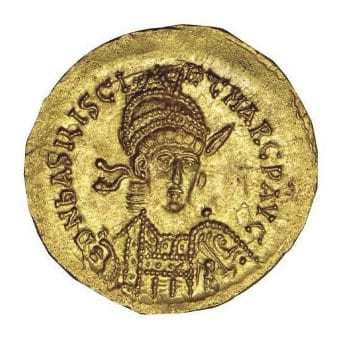Last Updated on November 27, 2023 by Vladimir Vulic
Life: AD ? – 476

- Became emperor AD 475.
- Wife: Aelia Zenonis (three sons; Marcus, Leo, Zeno).
- Died AD 476.
Basiliscus was the brother of Aelia Verina and hence emperor Leo’s brother-in-law.
In about AD 464 he became ‘Master of Soldiers’ in Thrace where he on several occasions successfully repelled invaders.
These successes, and the help of his sister, won him the position of ‘Master of Soldiers’ at the headquarters of the eastern empire in AD 468 and also gained him command over the huge joint eastern and western armada launched against the Vandals.
The size of this fleet is disputed but accounts tell of over one thousand ships carrying more than one hundred thousand men toward Africa. If Marcellinus, the western commander, performed well enough, then Basiliscus met with utter disaster. Off Carthage he suffered a surprise attack by a Vandal fleet. He lost most of his fleet and, with what little had survived, fled to Sicily.
Returning to Constantinople it was most likely only the protection of Aelia Verina which saved him from death. After all, Basiliscus’ failure had been so complete, it nearly caused the bankruptcy of the eastern empire. He retired to Heraclea (Marmara Ereglisi) in Thrace.
But in AD 474 Leo died and he was succeeded by his son-in-law Zeno the Isaurian.
Zeno though was very unpopular and it wasn’t long before a conspiracy was launched against him, headed mainly be Aelia Verina. Had the initial aim of the plot been to replace Zeno with Aelia Verina’s lover Patricius, then the senate rejected this candidate once Zeno had been deposed. Instead they chose as emperor Basiliscus, who had also been party to the conspiracy (AD 475).
How it had come to be that Basiliscus won the senate’s favour is unknown, but he almost at once assured that his rule would not be challenged by the former pretender by having Patricius put to death.
Basiliscus’ wife Aelia Zenonis was elevated to Augusta and his son Marcus was granted the rank of Caesar. Shortly afterwards Marcus was made co-Augustus and two more obscure, younger sons of Basiliscus, Leo and Zeno, were raised to be Caesars.
But such dynastic aspirations aside, things quickly began going wrong for the new emperor.
Early on a massive fire ravaged Constantinople, utterly destroying homes, churches, countless art treasures as well as emperor Julian’s massive library (containing over 120’000 books).
A further reason for Basiliscus’ deep unpopularity was his open favouritism toward the Christian Monophysite creed. To the people of Constantinople this was heresy. This not enough, Basiliscus created yet more religious controversy by quarreling with the patriarch of Constantinople.
Basiliscus also fell out with Theodoric Strabo, the powerful ‘Master of Soldiers’, by granting the same rank on a notorious playboy called Armatus, who apparently was the empress Aelia Zenonis’ lover.
The Isaurian general Illus, who had originally been party to the plot against Zeno, now had had enough of Basiliscus reign. Appalled by what he saw as bad government, he rejoined Zeno.
His old general back with him, and all support simply draining away from Basiliscus, Zeno felt the moment was right to leave his exile in Isauria and march on Constantinople.
Basiliscus tried all to reverse his fortunes, revoking his Monophysite religious edicts, but too late. No support was forthcoming.
Armatus, who had been sent east with the army to face off Zeno’s advance, chose to listen to the advice of his commanders to allow Zeno’s force to pass him by unhindered.
Zeno therefore marched on Constantinople unopposed, which he entered with no resistance in August AD 476.
Basiliscus, his wife and sons were sent to Cucusus in Cappadocia, where they were starved to death (AD 476).

Historian Franco Cavazzi dedicated hundreds of hours of his life to creating this website, roman-empire.net as a trove of educational material on this fascinating period of history. His work has been cited in a number of textbooks on the Roman Empire and mentioned on numerous publications such as the New York Times, PBS, The Guardian, and many more.
